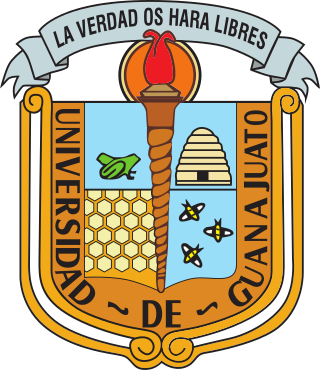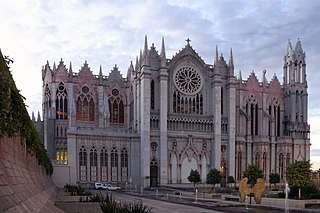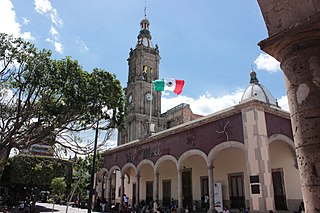Related Research Articles

Guanajuato is a municipality in central Mexico and the capital of the state of the same name. It is part of the macroregion of the Bajío. It is located in a narrow valley, which makes its streets narrow and winding. Most are alleys that cars cannot pass through, and some are long sets of stairs up the mountainsides. Many of the city's thoroughfares are partially or fully underground. The historic center has numerous small plazas and colonial-era mansions, churches, and civil constructions built using pink or green sandstone. The city historic center and the adjacent mines were proclaimed a World Heritage Site by UNESCO in 1988.

León, officially León de Los Aldama, is the most populous city and municipal seat of the municipality of León in the Mexican state of Guanajuato. In the 2020 Intercensal Survey, INEGI reported 1,721,626 people living in the municipality of León, making it the fourth-most populous municipality in Mexico. The metropolitan area of León recorded a population of 2,140,094 in the 2020 state Census, making it the seventh most populous metropolitan area in Mexico. León is part of the macroregion of Bajío within the Central Mexican Plateau.

Guanajuato, officially the Free and Sovereign State of Guanajuato, is one of the 32 states that make up the Federal Entities of Mexico. It is divided into 46 municipalities and its capital city is Guanajuato.

Guanajuato is a state in North Central Mexico that is divided into 46 municipalities. According to the 2020 Mexican census, Guanajuato is the sixth most populous state with 6,166,934 inhabitants and the 22nd largest by land area spanning 30,691.61 square kilometres (11,850.10 sq mi).

The Universidad de Guanajuato is a university based in the Mexican state of Guanajuato, made up of about 47,108 students in programs ranging from high school level to the doctorate level. Over 30,893 of those are pursuing undergraduate, masters, and doctorate degrees and 16,215 are in highschool. The university offers 215 academic programs, including 117 postgraduate programs, and 90 bachelor's degrees. The university has schools in fourteen cities throughout the state of Guanajuato.

León/Bajio International Airport ; officially Aeropuerto Internacional de Guanajuato, is an international airport situated in Silao, Guanajuato, Mexico. It is the main international airport serving the Greater León Metropolitan Area and the State of Guanajuato, which is home to a population of 6 million residents, including the cities of Celaya, Guanajuato, Irapuato, Salamanca, and San Miguel de Allende. In addition to offering domestic flights within Mexico, it serves as a gateway for international travel, connecting Central Mexico to various destinations in the United States. It serves as a focus city for Volaris and supports flight training, cargo, logistics and general aviation activities.

Silao, officially Silao de la Victoria, is a city in the west-central part of the state of Guanajuato in Mexico. It is the seat of the municipality with the same name. As of the 2005 census, the city had a population of 66,485, making it the seventh-largest city in the state. Silao is a center of agricultural and industrial activity.

The Bajío is a cultural and geographical region within the central Mexican plateau which roughly spans from northwest of Mexico City to the main silver mines in the northern-central part of the country. This includes the states of Querétaro, Guanajuato, parts of Jalisco, Aguascalientes and parts of Zacatecas, San Luis Potosí and Michoacán.

Salamanca is a city and municipality in the Mexican state of Guanajuato.

Axtel S.A.B. de C.V., known as Axtel, is a Mexican telecommunications company headquartered in San Pedro, near Monterrey. It offers telephone, internet, and television services through FTTH in 45 cities of Mexico as well as IT Services. It is the second largest landline telephone service provider and a relevant virtual private network operator.

Moroleón is a city located in the same name municipality of the state of Guanajuato, adjacent to the border with the state of Michoacán, in Mexico.

The Festival Internacional Cervantino (FIC), popularly known as El Cervantino, is a festival which takes place each fall in the city of Guanajuato, located in central Mexico. The festival originates from the mid 20th century, when short plays by Miguel de Cervantes called entremeses were performed in the city's plazas. Guanajuato is a small colonial-era city with a rich cultural history..

Irapuato is a Mexican city and municipality located at the foot of the Arandas Hill, in the central region of the state of Guanajuato. It lies between the Silao River and the Guanajuato River, a tributary of the Lerma River, at 1,724 m (5,656 ft) above sea level. It is located at 20°40′N101°21′W. The city is the second-largest in the state, with a population of 342,561 according to the 2005 census, while its municipality has a population of 529,440. The municipality has an area of 851 km2 (329 sq mi) and includes numerous smaller outlying communities. Although it is now an important center for regional trade and transportation center as well the site of several automotive and chemical manufacturing plants, the city's main industry has historically been agriculture and it has long been known for its strawberries and industry of refried beans, also the raising of pigs and cattle. The fruits and flowers of Irapuato's luxurious gardens are well known throughout Mexico.
TV4 is the state-owned public broadcaster serving the Mexican state of Guanajuato. It broadcasts on 30 total transmitters statewide and is operated by the Television Unit of Guanajuato (UTEG), which under its stated mission, provides educational programming, social and cultural television and healthy entertainment for children, youth and adults.
Federal Highway 45 (Fed. 45) is the free (libre) part of the federal highways corridors, and connects Ciudad Juárez, Chihuahua through the Chihuahuan Desert to Panales, Hidalgo.
Federal Highway 41 (Fed. 41) is a free (libre) part of the federal highways corridors of Mexico. The highway starts in the west at a junction with Fed37 about 10.6 km (6.6 mi) south-southwest of Manuel Doblado, Guanajuato. The highway travels east-northeast for 30 km (19 mi) before heading mostly south for 11.7 km (7.3 mi) toward Cuerámaro. From Cuerámaro, FH 41 travels 28 km (17 mi) east-southeast until reaching its eastern terminus at Fed. 90 in the locale of Munguia, Guanajuato. The highway's eastern terminus is 12.5 km (7.8 mi) southwest of Irapuato, Guanajuato.

Diego Sinhué Rodríguez Vallejo is a Mexican politician affiliated with the National Action Party (PAN) who is currently the governor of Guanajuato. He previously represented his state as a federal deputy in the LXII Legislature of the Mexican Congress.

Guanajuato handcrafts and folk art are mostly of European origin, although some indigenous work still survives in some communities. The most notable craft is the making of glazed mayolica pottery, followed by handmade traditional toys of various materials, especially a hard paper mache called cartonería. While handcrafts are not a large an industry here as in some other states, it does have several major handcraft markets which sell to tourists and foreign residents. Other handcraft traditions include wrought iron work, tin and glass, wood carving and leather working.
On 9 March 2019, a mass shooting occurred in La Playa Men's Club, a nightclub in Salamanca, Guanajuato, Mexico. Fifteen people were killed, and five to seven people were injured. Fourteen victims were later identified as Jalisco New Generation Cartel members. Witnesses described the attackers as a group of armed men who arrived in three vans.
The Santa Rosa de Lima Cartel or CSRL is a Mexican criminal organization from the state of Guanajuato. Founded in 2014, it was initially headed by "The Sledgehammer". They mainly earn their income from oil theft. In June 2020, it was reported that state government raids and turf wars with the Jalisco New Generation Cartel resulted in the Santa Rosa de Lima losing much of their territories in Guanajuato, Querétaro and Hidalgo and all of their "soldiers." However, cartel members still maintain a small presence in certain municipalities of Guanajuato, such as Villagrán, though they are not active in organized crime. Ortiz was captured by state and federal authorities on 2 August 2020 along with 5 other people.
References
z